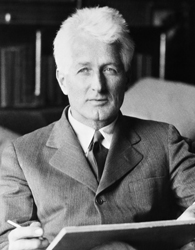Maxfield Parrish was one of the foremost artists and illustrators of the early 20th century. He’s particularly well known for his mystical paintings filled with fantastical scenery and vivid colors, which didn’t fit into a particular artistic school or movement, and for his signature “Parrish blue.”
Maxfield Parrish’s Early Days
Frederick Maxfield Parrish was born on July 25, 1870, in Philadelphia, Pennsylvania. He began drawing at a young age, and archived letters written by Parrish often show elaborate pictures sketched on their backs.
Parrish went to school at Haverford College and the Pennsylvania Academy of the Fine Arts. While he was studying at Drexel Institute he sought out instruction from Howard Pyle, but Pyle said that there wasn’t anything he could teach Parrish; after taking a few classes from Pyle, Parrish agreed.
Sources in this Story
- Been Publishing, I’m Back: Maxfield Parrish Biography
- The Parrish House: Maxfield Parrish Biography
- Smithsonian Magazine: Beyond the Blue: The Art of Maxfield Parrish
- National Museum of American Illustration: Maxfield Parrish
- Illustration House: Maxfield Parrish Biography
- The New York Times: King Cole, a Grimy Old Soul, Heads for Cleaning
Parrish’s Art
In the early 1900s, Parrish worked on many illustrations and murals, and his work could be seen in magazines, children’s books, department store windows and hotel lobbies. Bruce Watson of Smithsonian Magazine refers to Parrish as “the common man’s Rembrandt,” noting that his famous painting “Daybreak” from 1922 sold more than 200,000 copies.
He was the highest paid commercial artist in America during the 1920s. The National Museum of American Illustration claims that one of every four households in 1925 had one of Parrish’s prints.
Although Parrish’s early works were in black and white, he is most known for his extreme detail, vivid use of color and dream-like scenes. The Illustration House explains that the brilliant “Parrish blue” color and look of his paintings was achieved through layering paint with transparent varnish, a time-consuming technique but one that gave Parrish’s work the brilliant colors for which he is known along with the illusion of looking through a window.
One of Parrish’s most notable works is his “Old King Cole” mural, which was commissioned for John Jacob Astor IV to decorate the Knickerbocker Hotel. Parrish, who had a Quaker upbringing, was hesitant to complete the painting because it was meant for a bar. In now hangs in New York City’s St. Regis Hotel.
The Rest of the Story
By the 1940s, the popularity of Maxfield Parrish’s work had given way to that of a new American artist, Norman Rockwell. According to the Parrish House, Rockwell had a deep admiration for Parrish, saying that “He was in the Golden Age of Illustration…He was one of my gods.”
Parrish continued painting into his ‘90s, and his work regained popularity in the 1960s and ‘70s. He lived at his New Hampshire estate during his later years and, although he was married, Parrish also had a mistress for 55 years. She was the muse for many of female images in his paintings.
Although many Americans have seen prints of Parrish’s work, the Smithsonian points out that few people have ever seen a Parrish work in person, making him “one of America’s best-known and least-known artists.” Maxfield Parrish died in March 1966 at the age of 95.
This article was originally written by Lindsey Chapman; it was updated June 19, 2017.











